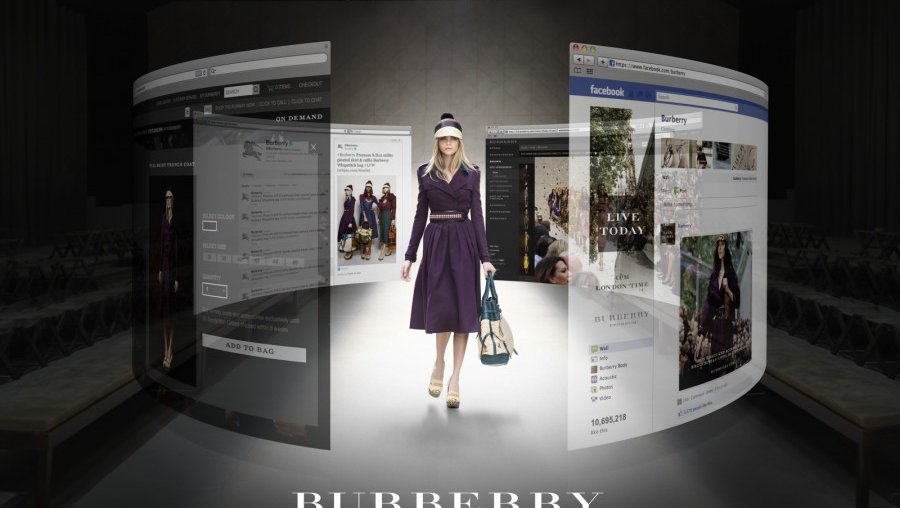Elizabeth Canon of Fashion’s Collective investigates how fashion brands are using digital technology to engage consumers during fashion week

Elizabeth Canon of Fashion’s Collective investigates how fashion brands are using digital technology to engage consumers during fashion week
Burberry leverage several social platforms to share their runway shows with consumers
Elizabeth Canon of Fashion’s Collective investigates how fashion brands are using digital technology to engage consumers during fashion week
To say Fashion Week has become consumer facing is a painful and exhausting understatement. Over the past few years, we have witnessed our industry transform fashion week from an insider event focused on driving orders and the bottom line, to an exercise in consumer marketing.
The industry seems to be divided. On one side, veterans who believe (admittedly or not) that Fashion Week should remain a strictly closed business-focused event, and not the circus it has reportedly become; and on the other those who want to crack Fashion Week wide open, using digital as a natural means to capture the consumer’s voyeuristic interest in the fantasy of the event.
Despite this divide, one look at industry headlines, or your Twitter feed, during Fashion Week makes it obvious that brands are embracing digital; as evidenced by the fact that marketing initiatives are now incorporated into the vast majority of shows and presentations.
Today, we’ll look at the common approaches to Fashion Week campaigns, and what brands need to consider to bridge the divide between generating hype and generating revenue.
“ What do brands need to consider to bridge the divide between generating hype & generating revenue? ”
The Usual Suspects:
At this stage, almost all Fashion Week marketing campaigns include some, if not all of these elements:
-Pre-show coverage: Teaser content posted on various social media sites
-Dedicated hashtag
-Dedicated microsite
-Exclusive content (backstage, b-roll, hair and makeup, interviews with designers, etc)
-Video (either through livestreaming or edited post-show video)
-Lookbook

Anya Hindmarch’s #whatplanet campaign
Strategic Approaches:
Whereas the elements above may represent the execution of a campaign, patterns are beginning to surface that indicate how brands differ in their strategic approach to a marketing initiative during Fashion Week.
This season, we’ve observed campaigns based on:
Theme: Brands like Anya Hindmarch have leveraged the creative design inspiration for the collection as the concept for the marketing campaign. Specifically, the designer’s planetary themed collection fueled the #whatplanet initiative where users created astrological charts on the dedicated microsite.
Technology: Certain brands have elected to center campaigns on a specific technology, usually because the technology has press appeal and isn’t otherwise available to the public.
This season’s examples included Burberry’s use of the iPhone5, which the brand used to shoot 15 minutes of show time while showing off the gadget’s new features like slow motion, and Nina Garcia’s use of Google Glass.
“ This season, we saw Tommy Hilfiger cater to the industry by rolling out the Social Concierge service ”
Sales: In years’ past, we’ve seen Facebook pop-up stores for fashion week, and of course tie-ins with pre-order retailers like Moda Operandi and Luisa via Roma.
This year, Marc Jacobs took a sales-focused approach by using runways images as the creative for banner ads that displayed across media outlets including the New York Times. The call to action prompted users to “reserve” the new collection, allowing the brand to capture marketing data and the customer to be notified once the item was available.
Aiding the Insider’s Experience: What most people outside the industry don’t understand is how draining and exhausting fashion week can be for those who are actually working during it.
This season, we saw Tommy Hilfiger cater to the industry by rolling out the Social Concierge service, armed with a team of 30 people who responded to inquiries in real time, serving up product details, images, etc. on demand to attendees.
Platform: More often than not, if a brand chooses to focus on a platform during Fashion Week it’s Instagram, Vine or Pinterest, something quick and visual. However, this Fashion Week we saw Snapchat entering the mix, as Rebecca Minkoff centered their campaign around this (highly scrutinzed) platform, which allowed followers a glimpse of the collection before it went down the runway.
“ Favourite platforms during Fashion Week tend to be Instagram, Vine or Pinterest, something quick & visual ”
Important Considerations
Regardless of the strategic approach or execution, brands would be remiss not to consider the following:
1. Microsite?
Creating a new microsite as part of the initiative comes with several pitfalls.
-571 new websites are created every minute, each competing for user’s attention. Add to that the amount of noise during Fashion Week and it’s no easy feat to get users to a destination they don’t already spend time on (or can even remember the URL for).
-An all-new site does not have the same SEO ranking and value compared to your established brand site.
-The staying power and long-term relevancy of a microsite is limited. For Fashion Week in particular, the content may still be interesting to consumers later when the collection becomes available in-store, but the microsite itself will feel dated.
2. New Platforms?
Using a platform your brand isn’t already actively part of can lead to low adoption and user frustration.
-Trying to drum up a following before an event can prove difficult, even with additional advertising budget.
-If your brand isn’t already intimately familiar with user behavior on a platform, you run the risk of having poor social media manners and ultimately frustrating users. (Think about the brands on Instagram who post several images in rapid succession, clogging up your feed).
Each platform comes with its own norms and behaviors, which change over time as users and the platform itself becomes more involved. This also applies to brands who have an established presence on a platform but decide to turn the posting over to a celebrity designer, creative director, etc during Fashion Week, it’s important this individual is up to speed on how the platform should actually be used.
3. Sales?
When capturing content at Fashion Week, the initial purpose may be all about branding, but at some point the collection will be available and it will be all about sales. Do the places you’re posting content drive traffic to eCommerce or allow for a sales capability down the line?
-Pinterest, for example, is a huge driver of referral traffic to eCommerce. Most brands create boards during Fashion Week, and these images continue to be shared by the larger Pinterest community as time goes on. However, the ultimate webpage each image links back to should continue to be accurate and live when the collection is available for purchase.
Separately, with Instagram, new platforms allow brands to create lookbooks and link through to eCommerce (52Grams is one such platform), providing longevity for your brand assets and convenience for your followers.
To further investigate fashion on Luxury Society, we invite your to explore the related materials as follows:
– Do We Really Need The Fashion Show?
– In Conversation With Michele Norsa, CEO, Salvatore Ferragamo
– It’s All About Made to Measure for Luxury Menswear










